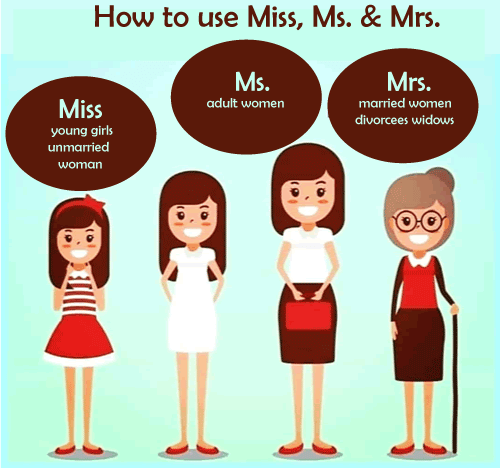Difference between Miss and MS"Miss" and "Ms." are terms used to address or refer to a woman. The main difference between the two is that "Miss" is typically used for an unmarried woman, while "Ms." can be used for a woman regardless of her marital status. 
Use of "Miss""Miss" is a title that is traditionally used for an unmarried woman. It is often used as a polite way to address a young woman or a woman who is not married. For example, one might address a letter to "Miss Jane Smith" or refer to a young woman as "Miss Smith." It is also commonly used as a term of address for young women in formal settings, such as a beauty pageant. Use of "Ms.""Ms." is a more recent term that can be used for a woman regardless of her marital status. It is often considered a neutral or polite alternative to "Miss" and "Mrs." (the title for a married woman). For example, one might address a letter to "Ms. Jane Smith" or refer to a woman as "Ms. Smith." It is also commonly used in professional settings, such as in business or in the workplace. In the past, "Ms." was primarily used as a title for women who were divorced or widowed. However, it is now commonly used as a title for any woman, regardless of her marital status. This is because "Ms." is seen as a way to avoid making assumptions about a woman's marital status, which can be seen as rude or disrespectful. In addition, "Ms." is also seen as a way to promote gender equality. By using a neutral title that applies to all women, regardless of their marital status, "Ms." helps to break down the traditional gender roles and expectations that are associated with "Miss" and "Mrs." Additional InformationOne thing to note is that the use of "Miss" and "Ms." can vary depending on the culture and region. In some cultures, it is more common to use "Miss" for all women, regardless of their marital status. In other cultures, "Ms." may be more commonly used, or there may be other titles used instead. Another point to consider is that while "Ms." is a more recent term, it has a long history of usage. It was first proposed as a title for women in 1901 by an American woman named Missy Stewart and also later in the 1930s by Missy Amelia Bloomer. It gained popularity in the 1970s as part of the feminist movement, as a way for women to assert their independence and reject the traditional gender roles associated with "Miss" and "Mrs." It's also worth noting that the use of "Ms." is not universal, and it may not be widely recognized or understood in all cultures. In some cultures, the use of "Ms." may be seen as a foreign concept or may not be considered appropriate. Additionally, when it comes to professional setting and business, it's more common to use "Ms." as a title for women, regardless of their marital status, to avoid making assumptions and to maintain a level of formality. In summary, "Miss" is traditionally used for unmarried women, while "Ms." can be used for any woman regardless of her marital status. "Ms." is considered a more neutral and polite alternative to "Miss" and "Mrs." and it is commonly used in professional settings, it promotes gender equality and has a long history of usage. However, the use of "Miss" and "Ms." can vary depending on the culture and region, and "Ms." may not be widely recognized or understood in all cultures.
Next TopicDifference between
|
 For Videos Join Our Youtube Channel: Join Now
For Videos Join Our Youtube Channel: Join Now
Feedback
- Send your Feedback to [email protected]
Help Others, Please Share










